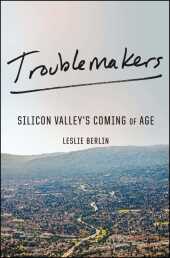 Neuerscheinungen 2017Stand: 2020-02-01 |
Schnellsuche
ISBN/Stichwort/Autor
|
Herderstraße 10
10625 Berlin
Tel.: 030 315 714 16
Fax 030 315 714 14
info@buchspektrum.de |

Leslie Berlin
Troublemakers
Silicon Valley Comes of Age
2017. 528 p. w. photos on pl. 234.95 mm
Verlag/Jahr: SIMON & SCHUSTER US 2017
ISBN: 1-501-17950-0 (1501179500)
Neue ISBN: 978-1-501-17950-1 (9781501179501)
Preis und Lieferzeit: Bitte klicken
Troublemakers Prometheus in the Pentagon
 BOB TAYLOR
It started with a crash. On October 29, 1969, a $700,000 Sigma 7 computer at UCLA sent a command to a slightly leaner SDS 940 machine at the Stanford Research Institute.
The UCLA machine looked formidable. A half-dozen or more refrigerator-sized components lined the perimeter of a special room dedicated to their use, the entire operation controlled by an expert sitting at a typewriter-looking console in the center of the room.
But when the UCLA machine sent its command-LOGIN-up the California coast, the Stanford computer crashed before the word, typed letter by letter, even got past G.
After a bit of reprogramming, the message was sent again and received, and the first computer network, called the Arpanet, was online. 1
This transmission, often hailed as the "birthday of the Internet," has been celebrated in conferences, books, speeches, and news reports. Plaques have been erected in its honor. One man who worked on the network at UCLA has since recast the failed initial login in biblical terms: "And so the very first message ever sent over the Internet was ´Lo!´ as in ´Lo and behold!´ Quite a prophetic message indeed." 2
Of course, no such message was intended. That LOGIN was the computing equivalent of Alexander Graham Bell´s "Mr. Watson, come here": a practical effort to determine if a message had been received. Whatever importance the LOGIN transmission has achieved by now, back in 1969, the sent message was not a momentous achievement. At UCLA and Stanford, there was a bit of applause and a lot of relief but no announcements from press offices, no reporters waiting to hear if the connection would work. A simple notation in a UCLA log book, "2230, Talked to SRI host to host," served as recognition. At the universities-and at the Pentagon, where the Department of Defense had funded this new network; and in Cambridge, Massachusetts, where a small company called Bolt Beranek and Newman was building the equipment and writing much of the software-most people involved with the network scarcely paused to note the transmission.
And Bob Taylor, the man who had jump-started the network, paid no attention at all.
Three years earlier, in 1966, three thousand miles from Silicon Valley in Washington, DC, Taylor had been walking back from lunch with his new employee, twenty-three-year-old Barry Wessler. To be more exact: Taylor was walking, and Wessler was sneaking in the occasional half jog to keep up. Taylor-thirty-four, slight, a cloud of pipe smoke obscuring a face that reminded more than one person of John F. Kennedy-did nothing at a sedate pace. Every morning Taylor squealed his rare BMW 503 into the giant Pentagon lot after driving as fast as possible from his home in suburban Maryland. He grabbed his heavy, hard-leather briefcase, clenched his pipe between his teeth, and strode through the halls of the Pentagon to his office in the D-ring, stepping neatly around the soldiers on adult-sized tricycles who rode up and down the endless corridors and the ramps between floors, delivering mail. Or he would skip the office and head to the airport for a trip to Boston or Pittsburgh or Palo Alto, so he could check on the research he was funding with an annual budget of $15 million to advance computer technology.
Taylor and Wessler worked at the Advanced Research Projects Agency (ARPA), which oversaw research initiatives for the Department of Defense. (ARPA is today called DARPA.) Taylor ran ARPA´s Inform
Berlin, Leslie
Leslie Berlin is Project Historian for the Silicon Valley Archives at Stanford University. She has been a Fellow at the Center for Advanced Studies in the Behavioral Sciences and served on the advisory committee to the Lemelson Center for the Study of Invention and Innovation at the Smithsonian´s National Museum of American History. She received her PhD in History from Stanford and her BA in American Studies from Yale. She has two college-age children and lives in Silicon Valley with her husband, whom she has known since they were both twelve years old. She is the author of Troublemakers.


